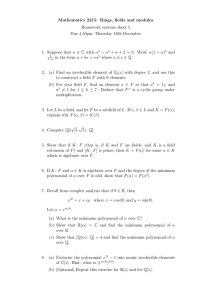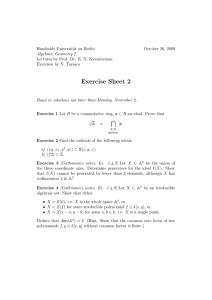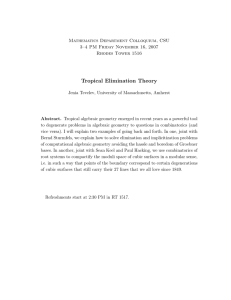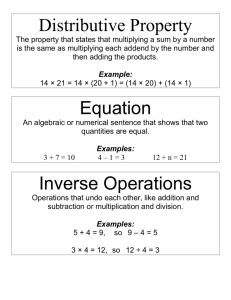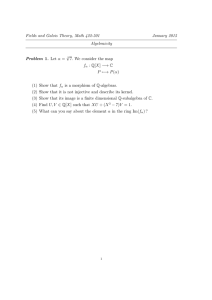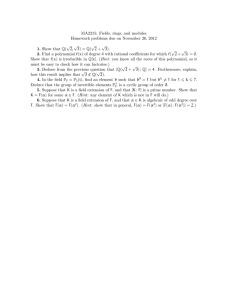A numerical algebraic geometry approach to regional Please share
advertisement
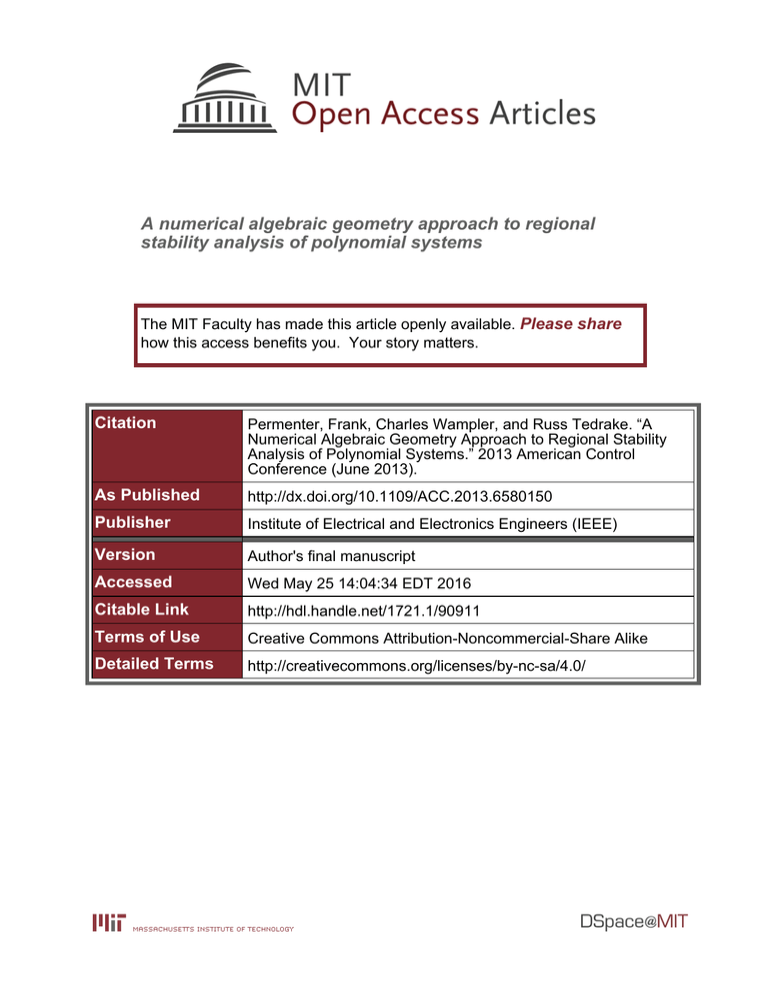
A numerical algebraic geometry approach to regional
stability analysis of polynomial systems
The MIT Faculty has made this article openly available. Please share
how this access benefits you. Your story matters.
Citation
Permenter, Frank, Charles Wampler, and Russ Tedrake. “A
Numerical Algebraic Geometry Approach to Regional Stability
Analysis of Polynomial Systems.” 2013 American Control
Conference (June 2013).
As Published
http://dx.doi.org/10.1109/ACC.2013.6580150
Publisher
Institute of Electrical and Electronics Engineers (IEEE)
Version
Author's final manuscript
Accessed
Wed May 25 14:04:34 EDT 2016
Citable Link
http://hdl.handle.net/1721.1/90911
Terms of Use
Creative Commons Attribution-Noncommercial-Share Alike
Detailed Terms
http://creativecommons.org/licenses/by-nc-sa/4.0/
A Numerical Algebraic Geometry Approach
To Regional Stability Analysis of Polynomial Systems
Frank Permenter1 and Charles Wampler
Abstract— We explore region of attraction (ROA) estimation
for polynomial systems via the numerical solution of polynomial
equations. Computing an optimal, stable sub-level set of a
Lyapunov function is first posed as a polynomial optimization
problem. Solutions to this optimization problem are found by
solving a polynomial system of equations using techniques
from numerical algebraic geometry. This system describes
KKT points and singular points not satisfying a regularity
condition. Though this system has exponentially many solutions,
the proposed method trivially parallelizes and is practical for
problems of moderate dimension and degree. In suitably generic
settings, the method solves the underlying optimization problem
to arbitrary precision, which could make it a useful tool for
studying popular semidefinite programming based relaxations
used in ROA analysis.
I. I NTRODUCTION
Suppose an ordinary system of differential equations has
an equilibrium point. A basic problem in nonlinear systems
theory is estimating the region of attraction (ROA) of the
equilibrium, which is defined as the set of initial conditions
that converge to the equilibrium as time tends to infinity.
It is common to inner approximate the region of attraction
with the sub-level set of a Lyapunov function. If the time
derivative of the Lyapunov function is negative definite in a
sub-level set, then the sub-level set is contained by the ROA.
It is therefore natural to ask what is the largest sub-level set
for which this condition holds.
This problem can be cast as a non-linear programming
problem which in general is computationally difficult. This
problem remains hard if one only considers polynomial nonlinearity [1], but specialized solution techniques become
available. In this paper, we describe a solution technique
arising from the field of numerical algebraic geometry and
demonstrate it is computationally feasible to numerically
compute the optimal sub-level set for polynomial systems of
reasonably low dimension (e.g. 1-6 states) in a reasonable
amount of time (sub-second to 10 minutes). Unlike classical
algorithms from algebraic geometry, the described solution
technique does not rely on symbolic computation and trivially parallelizes.
Regional stability analysis of course goes beyond showing
stability of a sub-level set of a Lyapunov function. Indeed,
finding a Lyapunov function is in its own right a difficult
1 F. Permenter and Russ Tedrake 3 are with the Computer Science
and Artificial Intelligence Laboratory (CSAIL), Massachusetts Institute of
Technology, Cambridge, MA 02139. {fperment,russt}@mit.edu
2 Charles Wampler is with General Motors Research and Development, Mail Code 480-106-224, 30500 Mound Road, Warren, MI 48090.
Charles.W.Wampler@gm.com, www.nd.edu/ cwample1.
2
and Russ Tedrake
3
problem. Nevertheless, we feel the proposed method could
be a useful computational tool for stability analysis.
II. P RIOR W ORK
Many techniques exist for studying regional stability of
polynomial dynamical systems. Perhaps the most common
are methods based on sums of squares optimization [11],
[10], [5], [14]. These methods allow one to certify emptiness
of semi-algebraic sets by solving a hierarchy of semidefinite
programs (SDPs). The optimal sub-level set problem we
consider (and many others) can be cast in this framework.
However, the size of the SDP required to exactly compute
the optimal sub-level set is currently poorly understood, and
the SDPs typically solved in practice only provably yield
inner approximations. Other approximation techniques based
on semidefinite programming include [8], which employs
the theory of moments, and [6] which considers a general
problem of bounding distance to a polynomial hypersurface.
The quality of the bound given in [8] improves as the size
of the SDP increases, but it is only known that the bound is
asymptotically tight. The paper [6] presents testable necessary and sufficient conditions for tightness of its bound, but
no quality measure for a loose bound is given. The proposed
method can assess the quality of each of these SDP based
approaches on specific instances of many systems studied in
practice. This could perhaps lead to better understanding of
these powerful techniques.
Another method based on quantifier elimination has been
proposed in [4]. While quantifier elimination is a powerful
theoretical tool, it typically scales to only very small problems in practice.
Finally, methods based on polynomial equation solving
have been suggested. For example, [7] finds points of tangency between the level set of a Lyapunov function V (x)
and the vanishing hypersurface of its time derivative V̇ (x)
using Groebner bases techniques. This tangency constraint
encodes local optimality of the polynomial optimization
problem we will consider if one ignores regularity conditions.
In addition, [7] assumes finitely many local optimizers and
relies on generally expensive computer algebra routines.
Interval arithmetic methods are considered in [15] and [17].
These methods employ numerical procedures for solving
polynomial systems and are therefore similar in spirit to the
technique we describe. They also extend to non-polynomial
systems. However, these methods struggle in the presence
of positive dimensional solution sets, an area that numerical
algebraic geometry handles gracefully.
Numerical algebraic geometry has found application in optimal control, for example [2]. Numerical algebraic geometry
is also a powerful tool for solving problems in kinematics
[16]. We offer, to our knowledge, its first application to
regional stability analysis.
∇x V (x) + λ∇x V̇ (x) + ζ∇x ( − xT x) = 0
V̇ (x) = 0
T
x x−≥0
ζ( − xT x) = 0
III. BACKGROUND
We begin our discussion by reviewing basic Lyapunov
theory for regional stability. We then give a non-linear
programming based description of provably stable sub-level
sets of Lyapunov functions.
A. Regional Stability Analysis
To begin, call a function V (x) a Lyapunov function iff
it is differentiable and positive definite with compact and
connected sub-level sets. Note that the connected condition
is non-standard, but is employed to simplify presentation.
One can use V (x) to study regional stability of the system
ẋ = f (x) by applying the following standard result:
Theorem 1: Suppose V (x) is a Lyapunov function and
V̇ (x) = ∇x V (x)T f (x) is continuous. Define Ωρ to be the
sub-level set {w : V (w) ≤ ρ} and int(Ωρ ) to be its interior.
If
∀x ∈ int(Ωρ ) \ {0}
V̇ (x) < 0,
(1)
then int(Ωρ ) is contained by the region of attraction.
Theorem 1 states if V̇ (x) is strictly negative for all nonzero points in the interior of a V (x) sub-level set, then all
solutions to ẋ = f (x) starting in the interior of the sub-level
set converge to the origin. It is therefore natural to ask what
is the largest sub-level for which condition (1) holds. If we
assume V̇ (x) is negative in a neighborhood of the origin, we
can define the largest sub-level set using the optimal value of
a constrained optimization problem. Consider the following
result, whose proof is straightforward and hence omitted:
Theorem 2: Let B(0, ) be an open -ball centered at the
origin and B(0, ) its closure. Let V (x) be a Lyapunov
function and suppose V̇ (x) is negative for all x ∈ B(0, ) \
{0}. If V ∗ is the optimal value of
V (x)
minimize
n
x∈R
subject to
V̇ (x) = 0 ,
x∈
/ B(0, )
(2)
then V̇ (x) < 0 for all x in the set
int(ΩV ∗ ) \ {0},
where ΩV ∗ is the sub-level set:
{x : V (x) ≤ V ∗ }.
Further, ΩV ∗ is the largest sub-level set with this property.
The optimal sublevel set ΩV ∗ of Theorem 2 can be found
if one can solve optimization problem (2). Since V (x) has
compact sub-level sets and is continuous, it is easy to show
that the optimal value of (2) is achieved if (2) is feasible.
The optimal value is achieved by regular points only if they
satisfy Karush-Kuhn-Tucker (KKT) optimality conditions:
(3)
ζ≥0
We can simplify these conditions by noting if V̇ (x) = 0
then − xT x 6= 0 by assumed negativity of V̇ (x) over
B(0, ) \ {0}. Thus, if V̇ (x) = 0 the complementary
slackness condition implies ζ = 0. Therefore, a point x
satisfies the KKT conditions only if
V̇ (x) = 0
.
∇x V (x) + λ∇x V̇ (x) = 0
(4)
The KKT conditions are necessary unless x is a singular
point of the curve V̇ (x) = 0, i.e. x solves the system:
∇x V̇ (x) = 0
.
V̇ (x) = 0
(5)
Calling Ssing the set of non-zero points solving (5) and Skkt
the set of non-zero x ∈ Rn that for some λ ∈ R solve (4),
we can express the optimal value of (2) as
V ∗ = inf{V (x) : x ∈ Skkt ∪ Ssing }.
(6)
In this paper, we will use numerical algebraic geometry
to study Skkt ∪ Ssing when (4) and (5) are polynomial. In
particular, a method is presented for checking the cardinality
of Skkt ∪ Ssing and for enumerating its elements in the finite
case. We also describe how to lower bound (6) if Skkt is
infinite.
B. Numerical Algebraic Geometry
For a detailed treatment of numerical algebraic geometry
one can see the book [12]. We briefly overview high level
topics, and first note that methods in numerical algebraic
geometry study polynomial systems over the complex numbers. Thus, additional care must be taken to reason about the
behavior (i.e. existence, cardinality, etc) of real solutions.
Letting z denote an indeterminate in Cn , we begin with
the following definition:
Definition 1: A solution z0 ∈ Cn to a polynomial system
g(z) is isolated if and only if no other solution to g(z) exists
in a neighborhood of z0 .
A basic operation in numerical algebraic geometry is enumerating isolated solutions via homotopy continuation. To
find the isolated solutions of some system g(z), one defines
a homotopy that smoothly deforms a start system h(z) with
known solutions into g(z). The homotopy and the start
system h(z) can be designed so that solutions of h(z) trace
smooth, continuous paths to all isolated solutions of g(z)
with probability one. Smoothness and continuity allow one to
find the isolated solutions of g(z) by tracking each path using
predictor-corrector methods. The appeal of this approach
is two fold: (1) all solutions can be performed in floating
point arithmetic and (2) each solution path can be tracked in
parallel.
All solutions to a polynomial system are isolated if and
only if the system has finitely many solutions. To describe
how numerical algebraic geometry applies to systems with
infinitely many solutions, we first define the notion of
irreducible algebraic sets and irreducible components of an
algebraic set. An algebraic set, i.e. the solution set of a
system of polynomial equations, is irreducible if it cannot be
written as the union of two of its proper algebraic subsets.
Irreducible components of an algebraic set Q = {z ∈
Cn : g(z) = 0} are irreducible algebraic sets Qi for which
Q = ∪i Qi .
Numerical algebraic geometry exploits the fact that a
random hyperplane intersects an irreducible algebraic set of
complementary dimension in a non-empty finite set of points.
Thus, points on a d dimensional irreducible component of
the set Q are isolated solutions of an augmented system
constructed from g(z) and d random, independent linear
equations. These points can be uncovered using homotopy
continuation to construct a witness point superset W d for
dimension d. The set W d contains points on each irreducible
component of dimension d and so called junk points on
higher dimensional components that are artifacts of the
continuation process. Junk points can be removed to enable
sophisticated algorithms for studying Q, but are benign in the
procedure we describe in this paper. If z ∈ Cn , one can build
sets W d for d ∈ [0, . . . , n] to construct a witness superset
for Q. The witness superset W contains the sets W d and the
intersecting hyperplanes for each dimension.
Given a witness superset, one immediately knows the
dimension of Q as well as the isolated solutions of g(z).
The dimension is simply the largest i for which W i is nonempty. The isolated solutions are contained in W 0 . Thus,
by constructing a witness superset, one can simultaneously
acquire the isolated solutions and determine if other positive
dimensional solution components exist.
Witness supersets can also be used to lower bound a
function over the real points in Q in a very special case.
Suppose a function w(z) : Cn → C mapping Rn to R is
constant over each irreducible component of Q. A lower
bound for w(z) over Q ∩ Rn is obtained by minimizing
w(z) over the set of points in W for which w(z) is real
valued. This procedure produces a lower bound because the
irreducible component containing the minimizing point in W
may not intersect Q ∩ Rn .
These crucial properties enable an algorithm for inner
approximating the optimal sub-level set of V (x) given witness supersets Wsing and Wkkt for the complex solution
components to (4) and (5). We discuss this algorithm in the
next section.
IV. A PPROACH
In this section we give an algorithm for finding a sub-level
set of a Lyapunov function V (x) contained by the ROA.
Under mild conditions, this set is the largest sub-level set
of V (x) satisfying the stability condition (1). The algorithm
is also equipped with testable sufficient conditions to verify
optimality.
Our procedure is explicitly given in Algorithm 1. When
systems (4) and (5) have finitely many complex solutions,
the algorithm essentially enumerates the sets of real solutions Skkt and Ssing to compute the optimal sub-level set
described by (6). If the KKT system (4) has infinitely many
solutions, the algorithm minimizes V (x) over the complex
solutions for which V (x) is real valued and positive. This
leads to a lower bound of (6).
We now describe key steps of the procedure. First the
algorithm computes witness supersets Wkkt and Wsing . It
then verifies from Wsing that (5) has only isolated solutions.
This implies Ssing is a finite set, a necessary requirement for
our algorithm to proceed (see Remark 1). Next the algorithm
minimizes V (x) over the union of three sets X1 , X2 and X3
constructed from Wkkt and Wsing . Sets X1 and X2 contain
the sets of non-zero, real, isolated points x that solve (4) and
(5):
0
X1 = {x : x 6= 0, (x, λ) ∈ Wkkt
∩ Rn+1 }
0
X2 = {x : x 6= 0, x ∈ Wsing
∩ Rn }
The set X3 arises from the positive dimensional components
of the solution set of (4) satisfying the following property:
• ∃(x, λ) in the component s.t. V (x) is real valued and
positive.
We can generate a set of samples X3 from these components
using Wkkt . In particular:
d
X3 = {x ∈Cn : (x, λ) ∈ Wkkt
,
d > 0, V (x) ∈ R, V (x) > 0}
By applying the following theorem, we can minimize V (x)
over these components by minimizing over the set of samples
X3 :
Theorem 3: If f (z) and g(z) are polynomials mapping
Cn−1 to C, then f (z) is constant on each irreducible
component of the algebraic set:
Q = {(z, λ) ∈ Cn : g(z) = 0, ∇z f (z) + λ∇z g(z) = 0}
Proof: Due to space constraints, we offer a brief sketch.
First, apply Cauchy-Riemann equations and the defining
equations of Q to show the directional derivative of f (z)
vanishes along any path through Q, if f (z) is viewed as
a function of the real and imaginary parts of (z, λ) and
Q is viewed as a subset of R2n . The result then follows
immediately from the fact irreducible components of Q, if
Q is viewed as a subset of R2n , are piecewise smoothly, path
connected [9].
Letting ρ denote
ρ = min{V (x) : x ∈ X1 ∪ X2 ∪ X3 }
(7)
gives the inequality:
0 < ρ ≤ inf{V (x) : x ∈ Skkt ∪ Ssing }.
The first inequality arises by construction of Xi and positive
definiteness of V (x) over Rn . The second inequality arises
V̇ (x) = 0
µ∇x V (x) + λ∇x V̇ (x) = 0 ,
a1 µ + a2 λ + 1 = 0
3
2
V −ρ = 0
V̇ = 0
x ∈ Xopt
1
V ≤ρ
x2
because X3 is constructed from points on components that
may not contain real solutions. This inequality is tight, i.e.
the calculated sub-level set is optimal, if V (x) = ρ for some
x ∈ Skkt ∪ Ssing . Obvious sufficient conditions for this are
as follows:
1) V (x) = ρ for some x in X3 ∩ Rn .
2) V (x) = ρ for some x in X1 ∪ X2 .
Remark 1: System (5) is required to have finitely many
complex solutions since it has no analogue to Theorem 3.
In other words, we cannot use Wsing to bound V (x) on the
complex solutions to (5) for which V (x) is real valued if
infinitely many complex solutions exist.
Remark 2: Witness supersets Wkkt and Wsing can be
extracted from a witness superset W for the polynomial
system
0
−1
V̇ ≥ 0
−2
V̇ ≤ 0
−3
−3
−2
−1
0
x1
1
2
3
Fig. 1: Region of attraction estimate for the Van der Pol oscillator
described in Section V-A. The set Xopt is the set of solutions to
optimization problem (2) and defines the optimal sub-level set. The
blue line indicates the boundary of the true ROA.
(8)
where µ is a new indeterminate and a1 , a2 ∈ R are random
d
fixed parameters. Construct Wkkt
from points in W d with
d
µ 6= 0. Take Wsing
to be all points in W d with µ = 0.
In practice, solving this combined system can be computationally cheaper than solving systems (4) and (5) seperately.
If the systems are solved seperately, a solver cannot exploit
the fact that solutions of (5) are indeed solutions to (4) “at
infinity.”
V. E XAMPLES
We discuss a few examples to illustrate the procedure and
its scaling properties.
A. Example 1: Van der Pol Oscillator
Consider the dynamics of a time reversed Van der Pol
oscillator:
−x2
f (x) =
.
(9)
x2 x21 + x1 − x2
This system has a stable equilibrium at the origin. To
estimate the region of attraction, we will identify a suitable
Lyapunov function V (x) and solve the polynomial optimization problem (2) by applying Algorithm 1.
To find a Lyapunov function, we first compute a linearization ẋ = Ax of (9) about the origin. Next, we solve the
Lyapunov equation for some positive definite matrix Q ∈ S2n :
AT P + P A = −Q.
Choosing Q to be the identity gives
3
− 12
2
.
P =
− 12
1
Noting that ẋ = Ax is stable, we conclude that V̇ (x) is
negative in a neighborhood of the origin for V (x) = xT P x.
Since V (x) satisfies the conditions of Theorem 2 we
estimate the ROA by solving the polynomial optimization
problem (2). We do this by generating a witness superset W
for the system (8). Introducing random real valued constants
a1 and a2 , this system takes the form:
−x31 x2 + 2x21 x22 − x21 − x22 = 0
µ(3x1 − x2 ) − λx1 (−4x22 + 3x1 x2 + 2) = 0
.
−µ(x1 − 2x2 ) − λ(x31 − 4x2 x21 + 2x2 ) = 0
a1 µ + a2 λ − 1 = 0
(10)
From W we construct witness supersets Wkkt and Wsing
for systems (4) and (5). We calculate a stable sub-level set
using the expression (7). Wkkt and Wsing reveal (4) and (5)
have only isolated solutions satisfying x 6= 0. This implies
the calculated sub-level set is optimal.
Constructing the witness superset W for (10) took 0.6
seconds on an Intel(R) Core(TM) i7-2600K CPU @ 3.40GHz
machine using the software package Bertini[3]. The calculated sub-level set is plotted in Figure 1, along with the set of
x that minimize (7), which we label Xopt . Note the geometric
interpretation of optimality: the optimal V (x) level set and
curve V̇ (x) = 0 are tangent.
B. Applications to N link manipulator
We now illustrate the scaling properties of the algorithm
by considering rigid body dynamics of a planar N link
manipulator pictured in Figure 2. The manipulator contains
rotary joints at each link. A control torque is applied at
all joints except for the base joint, hence this system is
underactuated. For N = 2, this system is sometimes called
an acrobot [13]. We will study regional stability of the
upright equilibrium point (qi = 0, i = 1, . . . , N ) when the
system is under LQR control.
Each link is modeled as a rod with uniform mass. The
base link has mass 1kg and length 1m. All other links have
mass 1.2kg and and length 1.2m. Each joint has a viscous
1
N · m · s.
damping constant equal to 10
2n
We let x = (q, q̇) ∈ R and let u ∈ RN −1 denote the
control torques. We stabilize with an LQR controller calculated using dynamics linearized about the upright. Defining
In to be the identity matrix in Rn×n , we set Q and R equal
N
4
3
2
i
i |W |
12925
1415
148
P
Paths
106633
11945
1228
Solve Time (s)
10600
280
8.6
1
V −ρ = 0
V̇ = 0
T w ∈ Xopt
0.8
0.6
V̇ ≥ 0
0.4
0.2
w4
TABLE I: Metrics for the N -Link manipulator of Section V-B for
different values of N . Shown are total paths tracked by Bertini
[3] in the construction of witness point supersets W i for
P system
i
(8). The total number of points in the W i is denoted
i |W |.
System (8) has one linear and 2N + 1 quartic equations in 2N + 2
variables. Computation was performed on an Intel(R) Core(TM)
i7-2600K CPU @ 3.40GHz machine using 8 execution threads.
V ≤ρ
0
−0.2
−0.4
−0.6
−0.8
−1
−1
−0.8
−0.6
−0.4
−0.2
0
w2
0.2
0.4
0.6
0.8
1
to
0.4
Q=
10In
0
0
In
R=
In−1
.
V −ρ = 0
V̇ = 0
T w ∈ Xopt
0.3
0.2
q
3
g
u2
q
u1
2
q
1
Fig. 2: The N -link planar manipulator considered in Section VB for N = 3. Control torques u1 and u2 are applied to joints q2
and q3 respectively. System parameters for examples considered are
given in Section V-B.
VI. D ISCUSSION
In each example we considered, V̇ (x) had no non-zero
singular points, i.e. system (5) had no non-zero solutions.
0.1
w3
We set V (x) to be the LQR cost-to-go and Taylor expand
the closed loop dynamics to 3rd order. We then construct
the polynomial system (8), which contains 2N + 1 quartic
equations and one linear equation in 2N + 2 unknowns. We
calculate a witness superset W for (8) and from it construct
witness supersets Wkkt and Wsing .
We consider cases for N = 2, 3, 4. In all cases, the
minimizing x for (7) is real valued. We conclude the sublevel set defined by (7) is optimal for each choice of N .
Computational summaries for witness superset calculations
are given in Table I.
For the N = 2 case, we plot slices of the calculated sublevel set in Figure 3. Taking S to be to cost-to-go matrix
and T = S −1/2 , we apply a change of coordinates x = T w
so that the Lyapunov function V (T w) has circular sub-level
sets in w. This is strictly for aesthetic purposes. We plot two
slices of the ROA in these coordinates by fixing w1 and w3
(resp. w2 and w4 ) to the values given by w = T xopt , where
xopt is the minimizer of the expression given by (7).
V̇ ≥ 0
V ≤ρ
0
−0.1
−0.2
−0.3
−0.4
−0.5
−0.4
−0.3
−0.2
−0.1
0
w1
0.1
0.2
0.3
0.4
0.5
Fig. 3: N -Link Example. Slices of an ROA estimate found for a
2-link planar manipulator discussed in Section V-B. For plotting
purposes, we have applied a change of coordinates x = T w so that
V (T w) has circular level sets in w. The level set plotted is for
ρ = 0.188.
Moreover, the only solutions to the KKT system (4) satisfying x 6= 0 were isolated. This is perhaps not surprising, and
suggests that heuristically searching for just the isolated solutions of the KKT system would be useful in practice. This
simplication could yield significant computational savings.
If we were to adopt an approach of only finding isolated
solutions, we could also apply coefficient-parameter homotopy theory to efficiently update the optimal sub-level set
after changes to the Lyapunov function or system dynamics
are made (perhaps an order of magnitude reduction in
solution paths). Such an approach would perhaps be useful
in controller design or in the search of Lyapunov functions.
VII. C ONCLUSION
In summary, we have proposed a method for region of
attraction estimation based on numerical algebraic geometry
and quantified its computational requirements. Under mild
conditions, the proposed technique can find the optimal sublevel set to desired precision. This could make it useful
for studying existing approximation algorithms for ROA
estimation that sacrifice optimality for some other feature
(e.g. speed). In addition, the algorithm recovers the optimal
solution of (2) as opposed to just the optimal value. In
contrast, recovery of the optimal solution in sums of squares
methods, for example, is not always possible. It would be
interesting to explore how optimal solutions can be used to
Input: A polynomial Lyapunov function V (x) and
polynomial dynamical system f (x) with equilibrium
at the origin
Output: A parameter ρ for which {x : V (x) ≤ ρ} is
asymptotically stable.
#Compute V̇ (x), ensure it is negative around origin
V̇ (x) = ∇x V (x)T f (x)
unless ∇V̇ (0) = 0 and ∇2 V̇ (0) ≺ 0 return 0
#Compute witness superset for polynomial system (8)
W = W itnessSuperSet(V (x), V̇ (x))
#Split into witness supersets for (5) and (4). See Remark 2.
[Wkkt , Wsing ] = SplitW itnessSuperSet(W )
#Require finitely many solutions to (5). See Remark 1.
i
unless |Wsing
| == 0 ∀i > 0 return 0
#Build sets from Section IV and minimize V (x)
[X1 , X2 , X3 ] = BuildXSet(Wkkt , Wsing )
X = X1 ∪ X2 ∪ X3
ρ = minx∈X V (x)
return ρ
Algorithm 1: Computes a stable sub-level set of a Lyapunov
function.
update Lyapunov functions, since they represent the precise
points where the stability condition (1) fails.
R EFERENCES
[1] A. A. Ahmadi, A. Majumdar, and R. Tedrake. Complexity of ten
decision problems in continuous time dynamical systems. In To appear
in ACC 2013.
[2] D. J. Bates, I.A. Fotiou, and Ph. Rostalski. A numerical algebraic
geometry approach to nonlinear constrained optimal control. In IEEE
Conference on Decision and Control, New Orleans, LA, dec 2007.
[3] D. J. Bates, J.D. Hauenstein, A.J. Sommese, and C.W. Wampler.
Bertini: Software for numerical algebraic geometry. Available at
http://www.nd.edu/∼sommese/bertini.
[4] H. Burchardt and S. Ratschan. Estimating the region of attraction
of ordinary differential equations by quantified constraint solving.
In Proceedings of the 3rd WSEAS/IASME International Conference
on Dynamical Systems and Control, CONTROL’07, pages 241–246,
Stevens Point, Wisconsin, USA, 2007. World Scientific and Engineering Academy and Society (WSEAS).
[5] G. Chesi. Domain of Attraction: Analysis and Control via SOS
Programming. Springer, 2011.
[6] G. Chesi, A. Tesi, A. Vicino, and R. Genesio. On convexification of
some minimum distance problems. In European Control Conf, 1999.
[7] K. Forsman. Applications of Groebner bases to nonlinear systems. In
In Proc. First European Control Conf, pages 164–169. Hermes, 1991.
[8] O. Hachicho and B. Tibken. Estimating domains of attraction of a
class of nonlinear dynamical systems with LMI methods based on the
theory of moments. In Decision and Control, 2002, Proceedings of the
41st IEEE Conference on, volume 3, pages 3150–3155. IEEE, 2002.
[9] M. Laurent. Sums of squares, moment matrices and optimization over
polynomials. Emerging Applications of Algebraic Geometry, pages
157–270, 2009.
[10] A. Papachristodoulou and S. Prajna. On the construction of Lyapunov
functions using the sum of squares decomposition. In Proceedings of
the 41st IEEE Conference on Decision and Control, Dec 2002.
[11] P. A. Parrilo. Structured Semidefinite Programs and Semialgebraic
Geometry Methods in Robustness and Optimization. PhD thesis,
California Institute of Technology, Pasadena, CA, 2000.
[12] A.J. Sommese and C.W. Wampler. The Numerical Solution Of Systems
of Polynomials Arising in Engineering and Science. World Scientific
Publishing, Hackensack, NJ, 2005.
[13] M. Spong. The swingup control problem for the acrobot. IEEE Control
Systems Magazine, 15(1):49–55, February 1995.
[14] B. Tibken. Estimation of the domain of attraction for polynomial
systems via LMIs. In Decision and Control, 2000. Proceedings of the
39th IEEE Conference on, volume 4, pages 3860–3864. IEEE, 2000.
[15] B. Tibken and O. Hachicho. Estimation of the domain of attraction
for polynomial systems using multidimensional grids. In Proceedings
of the IEEE Conference on Decision and Control, feb. 2000.
[16] C.W. Wampler and A.J. Sommese. Numerical Algebraic Geometry
and Algebraic Kinematics. Acta Numerica, 20:469–567, 2011.
[17] S. Warthenpfuhl, B. Tibken, and S. Mayer. An interval arithmetic
approach for the estimation of the domain of attraction. In ComputerAided Control System Design (CACSD), 2010 IEEE International
Symposium on, pages 1999 –2004, sept. 2010.
